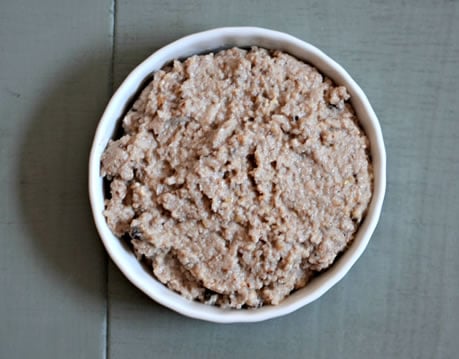Charoset, haroset, or charoses (Hebrew: חֲרֽוֹסֶת [ḥărōset]) is a sweet, dark-colored paste made of fruits and nuts eaten at the Passover Seder. Its color and texture are meant to recall mortar (or mud used to make adobe bricks) which the Israelites used when they were enslaved in Ancient Egypt as mentioned in Tractate Pesahim (page 116a) of the Talmud, which says " The word "charoset" comes from the Hebrew word cheres — חרס — "clay."
Charoset is one of the symbolic foods on the Passover Seder Plate. After reciting the blessings, and eating a matzah "Hillel sandwich"(with two matzot) combining charoset and maror, the remainder is often eaten plain, spread on matzah.
History
Charoset is mentioned in the Mishna in connection with the items placed on the Passover table: "unleavened bread and lettuce and charoset." Some say it can be traced back to the custom of symposia in ancient Greece, where philosophical discussions were accompanied by drinking large quantities of wine and consuming foods dipped into mixtures of pounded nuts and spices.
Variations
There are many recipes for charoset. Many include at least some of the fruits and spices mentioned in the Song of Songs: apples 2-3, figs 2-13, pomegranates 4-3, grapes 2-15, walnuts 6-11, dates 7-7 with the addition of wine 1-2, saffron 4-14 and cinnamon 4-14.
Ashkenazi traditions
Eastern European (or Ashkenazi) charoset is made from chopped walnuts and apples, spiced with cinnamon and sweet red wine. Honey or sugar may be added as a sweetener and binder. The mixture is not cooked. Many Ashkenazim refer to any charoset that includes fruit other than apples as "[name of fruit] charoset" as they do not consider it to be "charoset" in a strict sense.
Sephardi traditions
Sephardi charoset is a paste made of raisins, figs and dates.
Egyptian Jews make it from dates, raisins, walnuts, cinnamon, and sweet wine.
Greek and Turkish Jews use apples, dates, chopped almonds, and wine. Italian Jews add chestnuts.
Some Spanish and Portuguese communities such as the Jews of Suriname, add coconut.
Yemenite tradition
Yihye Bashiri (17th-century) described the manner in which the charoset was made in Yemen: "They take figs or raisins or dates, and pound them into the consistency of dough. They then put vinegar thereto, and add spices. Some there are who put ground sesame seeds into this admixture. On the night of the Passover, a person is required to put therein whole spices that have not been ground; either two or three seeds of valerian (Arabic: sunbul), or sprigs of marjoram [alternatively: wild thyme ] (Arabic: za'tar), or savory (Arabic: hasha), or things similar to them, so that it will resemble straw in mortar – in remembrance of that thing by which our fathers were enslaved in Egypt, seeing that it is like unto bricks and straw." In Yemenite Jewish tradition, the charoset is also called "dukeh" (Hebrew: דוכה), a name also referred to as such in the Jerusalem Talmud.
Mizrahi traditions
Not all Jews use the term "charoset". Some of the Jews of the Middle East instead use the term "halegh". The origin of halegh is not clear. Rav Saadia Gaon uses the word and attributes it to a kind of walnut that was a mandatory ingredient in the preparation of the halegh.
Parts of the Jewish Diaspora in Iran have a tradition of including forty different ingredients in the halegh. The number forty signifies the forty years of wandering in the desert.
Modern variations
In 2015 Ben & Jerry's Charoset ice cream became widely available in Israel and was covered in several major news outlets
Less than a week until Seder night means it’s definitely time to start thinking about the Seder plate foods, including charoset—a mixture of apples, nuts and wine which resembles the mortar and brick made by the Jews when they toiled for Pharaoh. This is used as a type of relish into which the maror (bitter herb) is dipped (and then shaken off) before eating.

The base of any charoset is sweet apple and/or pear, walnuts and red wine. Fruit—small dice, large dice or grated, that’s up to you. Nuts chopped or ground—again, up to you. It’s a matter of taste. Can’t decide? Make a few versions and have a vote.

Some people like to add dried fruit like raisins, dates, prunes or apricots, and spices like cinnamon, nutmeg, cloves or allspice. Desiccated coconut can add another layer of texture, and is a good alternative for the nut-allergic.

I’ve got four variations for you here, but feel free to play around and come up with your own.
Simple Chabad-Style Charoset

1 red apple
1 pear
1 cup chopped or ground walnuts
½ cup sweet red wine
Peel and finely dice the apple and pear. Mix in the ground nuts and wine. Refrigerate until serving. Add a little more wine immediately before serving.
Chunky Charoset

1 apple
1 pear
1 cup chopped or ground walnuts
½ cup raisins
½ cup sweet red wine
¼ tsp. cinnamon
¼ tsp. nutmeg
Peel and finely dice the apple and pear. Mix in the ground nuts, raisins, wine and spices. Refrigerate until serving. Add a little more wine immediately before serving.
Smooth Charoset

Use any of these recipes and pulse in a food processor until it reaches a thick paste consistency.
Nut-Free Charoset

1 apple
1 pear
1 cup desiccated coconut
½ cup raisins
½ cup sweet red wine
Peel and finely dice the apple and pear. Mix in the rest of the ingredients. Refrigerate until serving. Add a little more wine immediately before serving.

There’s one major “problem” with charoset—it’s customary to shake the charoset off the maror before eating, but the charoset is quite delicious! So, set some charoset aside in a separate container for later use. Mix it into your breakfast yogurt, or serve warm with a scoop of vanilla ice cream.
Play Video
Traditional Passover Charoset
0
BY MIRIAM SZOKOVSKI
No comments:
Post a Comment